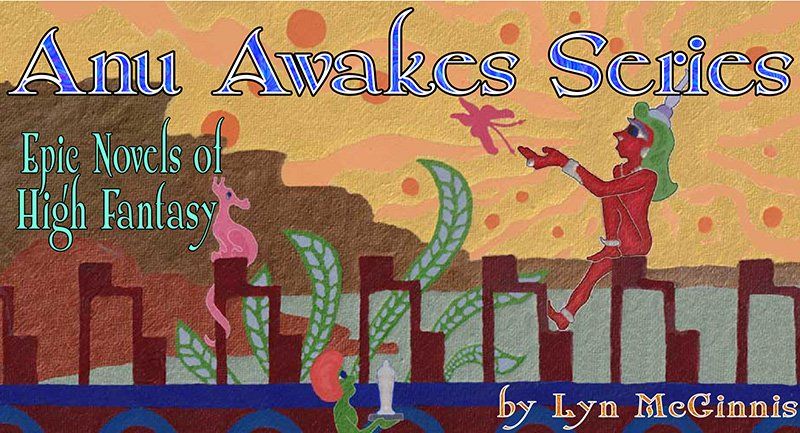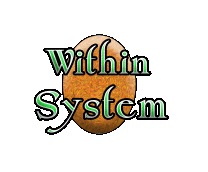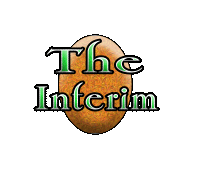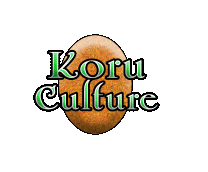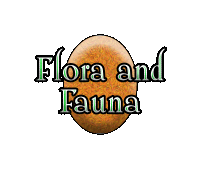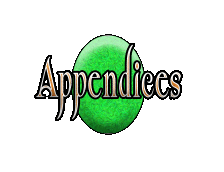
Cousins are the closest living relatives to the Tolku
and later the Koru, Yakku
and Yelda. They range in size from the smallest, who live in the trees or on the roofs of buildings, to those far taller and broader than an adult Koru. They are well regarded for their companionship with the early Tolku and their long and faithful service during the Primary Epoch. They also have the notable distinction of being ‘Crossover Servants’ after the Killing Swath. Different members of this group assisted the survivors who became Koru from those who became Yakku.
Background
Origins and distribution, Natural partners, Unwitting bridge for Brangnam Plague, Cousins warn of Suvuka Onslaught, Cousins first among animals, Secondary Epoch employment of Cousins
Tree Dwellers
Long-Tailed Troupes
Patzku, Varku, First among Cousins, Premature birth necessary, Varku and Elders, Urban Varku, Yakku destroyed Varku of Thermistal
Massive Land Walkers
Origins and distribution
An extended study inside and outside the Living System
during the Primary Epoch
concluded that all branches of Cousins, and eventually Tolku, originated in the jungles, southern forests and plains of Statos-Vey. For vast periods, they only foraged on the subcontinent before gradually moving across the Pax Zenam Ridge
in modest waves onto Rho-Jashun
and filling the south and central portions of the continent. At some point, all but the two most extensive branches of Cousins found a way to migrate across the Panchala Sea
to Thermistal, although only the three small tree-dwelling branches thrived in the dense western forests.
Natural partners
The Tolku
arose and distinguished themselves as the most intelligent and organized of the Cousins. Evidence shows they became the first on Anu
to grow the Collective Crown
by patient increments. These now fully self-aware Tolku realized these Cousins were most closely related to themselves. Early in Tolku pre-history, they began to find other ally creatures along with very early explorations into their deep understanding of plants and trees. Still, they discovered they could carefully cultivate particular relations with their Cousins, fashioning symbiotic relationships in prehistoric times and treating them as their natural partners in life. During the Lesser Era, the first Unifying Dynasty of the Funomanru granted rights to all Cousins to ensure they were not overworked or abused. Of all living beings other than themselves, the Greater Era
Tolku Cluster-of-Clusters Nation
devoted the most time to modifying the cousins to serve Tatchlan.
Unwitting bridge for Brangnam Plague
What would become the scourge of prehistory for the early Tolku, the antecedents of the Brangnam Plague
had long existed in far less virulent form among all branches of Cousins. For them, this was an infection that only killed the young, old and already vulnerable. While debilitating, it seldom destroyed the strong and healthy. Despite being near relations of all Cousins, once Brangnam attached itself to the early Tolku, it turned deadly. What circulated among the Cousins remained largely unaltered and persists as a relatively minor incident in a troupe’s life.
Cousins warn of Suvuka Onslaught
One of the first historical events illustrating the deep bond between the Tolku
and their Cousins was when, near the end of the Lesser Era
of the Primary Epoch, the Tatchlan Masters
received early warning
of the Suvuka
having landed on the Huallapandu Headlands
on the northern tip of Rho-Jashun
by flocks of Krall
and a network of cousins sending messages south to them. The largest cousins even fought with the Suvuka to effect a partial withdrawal of Tolku communities from this new threat. These cousins were carefully integrated into the Cluster-of-Clusters Nations
throughout the rest of the Primary Epoch and the Secondary Epoch. They even had in-depth instruction embedded in them to awaken after a long dormancy, such as The Killing Swath, to aid those surviving catastrophes.
Cousins first among animals
The small tree dwellers, particularly the Asaku and the Mayku, were completely domesticated and used in many ways. At the same time, the large and powerful Tamku
also became an essential part of every Tolku group. Of all the creatures the Tolku worked with, first among them were their ‘Cousins,’ while all other animals were their ‘allies.’
Secondary Epoch Employment of Cousins
After the agony of the Killing Swath
and the beginning of The Interim, Cousins and Krall
distinguished themselves among the surviving Guardians as Crossover Servants. Their deep conditioning allowed them to immediately assist the First, Second and Third Generations
within and without their mountain Sanctuaries. It was revealed at this time that in this emergency, secret doors were opened within the Varku, and they were suddenly able to see through the eyes of the Krall, albeit not while in any way entering Tatchlan. Their links to the emerging Koru
and Yelda
were reinforced during the Secondary Epoch. The Yakku
primarily use the little tree-dwellers as messengers. The Koru also operate the first two classes, although they changed them to do so underground and within their Living Mountains. They save the most substantial cousins for heavy work. The Yelda use the first group for messaging, the second for indoor and outdoor duties, and the third for heavy labour.
Cousins are divided into three groups
Tree-dwellers
Asaku
These are the most diminutive
of cousins. They are bright yellow with dramatic blue and green markings on their faces, hands, feet and tails. They served the Tolku, and later the Koru
and Yelda, to send and receive important messages, usually dispatched in groups of four or more. They have a characteristically piercing cry heralding their arrival.
They also work within the Kudurapala
of the Mahamdul Naval Empire. They perform many specialized tasks aboard their ships and fulfill similar roles in their urban areas. These smallest and lightest cousins are the most common in Cluster-of-Cluster
societies throughout Anu. They are most utilized among the Yakku
in their high forest canopies, where they could be trained remarkably, including interpreting various verbal commands.
It may be noted here that Cousins are accorded the same honorific Primary Epoch Border
as Living Instruments, in as much as all Cousins are products of substantial improvement within the Living System
throughout the Primary Epoch.
Mayku
These tree-dwellers
are longer in the body than Asaku but share many traits and environs. They are dark blue to black, with bright yellow ringing around their eyes. They also primarily serve as messengers and are the most common. They have a 'hooting' call.
The Mayku is a head longer than the Asaku. They are known for taking up Asaku
or Tecku
young they find and raising them as their own. They also happily groom members of the other two small cousin groups. These are said to be signs of early Tatchlan
modification. The raw Mayku displayed neither of these social tendencies in the Lesser Era
of the Primary Epoch.
They are distinguished by having faint circular patterns
on their pelts, not unlike that found on most Living Instruments. This is seen as a sign of their depth within the Resplendent Work.
Tecku
While the Tecku
approaches the size of a small Tolku
or Yeldic pre-adult, their arms are far longer, making it difficult to walk long on the ground without dragging them or assuming a posture of crossing their arms or holding them high in the air. They are dark green with brown and black patterns on their faces and rumps. They are powerful for their size and are the deliverers of packages and carriers of small burdens over great distances within and outside cities. They usually carry them on their backs or are outfitted with a harness to strap them on their shoulders.
The Tecku are unique in being employed by the Yakku
in the trees and the Koru
deep within their mountains, particularly within their Living Mountains. They are the largest tree-dwellers tasked with carrying larger packages and other items over long distances by the Yakku.
The Koru engage them exclusively in large open spaces within their mountains, especially retrieving and returning material stored on interior walls. Their pelts are dark blue on the backs and white on their underside, including inner arms and legs. Their faces are a pale blue mask and are topped by a crown of stiff hair rising over their heads.
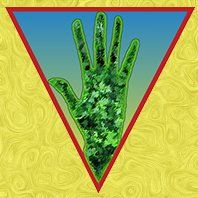
The Yakku
are known to extensively use the Asaku, Mayku and Tecku, integrating them into the Yakku Collective of Viracocha
at each of their Eight Levels. Since The Interim, they have been bred and trained to perform various tasks, ranging from tiny companions and messengers to labourers. The Yakku never employed the larger cousins within their forests and jungles. This was because they were less used in the canopy and out of fear of their reawakening Tatchlan.
Officially, in very recent times, these small cousins have gone wild within Yeldic
Thermistal
east of the Silvasora Mountains
due to religious prohibitions. Yet, the military has always used them for messages.
Long-Tailed Troupes
Patzku
These creatures
are far larger than the tree runners but still shorter than an adult Tolku, or later a Yelda. They travel in sizable troupes and are deployed outside the cities to serve ministries
and rural communities. They are dull brown with distinctive white accents around their snout and mouth.
They have become specialized in managing large herds of domesticated animals and can also distinguish ripe fruit needing picking from orchards. They may even be trained to assist in harvesting Salarish
and other cereal crops. As such, they are treasured servants of Rural Clusters
who
employ
them extensively.
Varku
Similar in size to Patzku, these are by far the most intelligent and, therefore, one of the most cultivated by the early Tatchlan Masters of all cousins. They are orange and red in colour and travel in small but tightly-organized troupes. They are primarily found in urban environments and perform a wide variety of tasks both outdoors and in. They alone can direct all the other Cousins, bigger and smaller than themselves, summoning them from great distances by high-pitched calls.
First Among Cousins
They are prominent within the Living System and distinguished as having roles in Generational Plans. During the Primary Epoch, they had sealed within them protocols to quicken in specific times of disruption and emergency. This was documented after the Killing Swath
when the last Tolku
and first Koru
found them invaluable aides in saving aspects of Tatchlan, protecting the Guardians
and marshalling other surviving Cousins to assist them.
Premature birth necessary
Early in the Greater Era
of the Primary Epoch, the Tolku
Majastas
saw the need to augment the already impressive capacity of the Varku
by increasing the dimensions and intricacy of their brains. As expected, this immense Generational Plan
was enacted early in the Tolku
age and continued for millennia. This illustrated the powers and confidence of the early Majastas dynasties. The vigour and potency of the Living System
were ever-expanding, and, as yet, none of the later challenges had arisen. Over hundreds of generations, the Varku’s brains escalated in size and complexity. Most of the physical growth took place at the backs of their heads. This development necessitated three other alterations. One was to all Varku’s necks and backs, which also grew in girth and strength to support the larger head. Another was an increase in the pelvis width of females. The third concern was that these new versions of Varku of necessity were born prematurely. Even with their increased pelvis size, for mothers to successfully give birth to infants with such an increased head size, they needed to emerge sooner. It was noted that Raw Life
blindly enlisted similar protocols for the prehistoric Tolku, who, compared to all other Cousins, are born sooner and require more physical support and cultural instruction than others. In this way, the Varku most resembled the Tolku, and in the Secondary Epoch, the Koru, Yakku
and Yelda
in their premature state at birth and extended pre-adulthood.
Varku and Elders
The Varku are close companions of the Elders
of both urban and rural clusters. They assist in directing the cluster’s cousin population in the wide variety of uses they perform. The Elders are aided in this by the Cousin Touched
of each cluster. Those clusters without this specialized member of the Touched
Class will do much to secure the services of one in their area.
Urban Varku
In the Secondary Epoch, particularly in the Danam Yelda’s Cluster-of-Clusters Nation, most non-living structures are fitted with protrusions so these three more substantial groups of cousins can scale them as needed. Traditionally, those living within the city live on the top of public buildings. Here, the Varku co-ordinate the activities of the Asaku, Tecku
and Mayku
couriers across the roofs. Upata Bulbs
accommodates Cousins with ease.
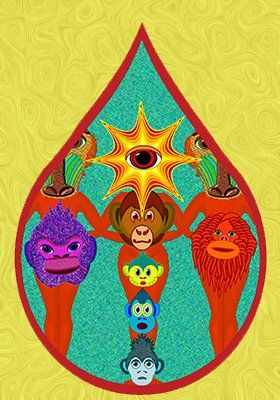
Yakku destroyed Varku of Thermistal
All these abilities and powers of the Varku
were known to the first Yakku
of Thermistal, who chose to turn their backs on the Tatchlan legacy. While they had no qualms in using the smaller cousins, so clearly modified throughout the Primary Epoch
by Tatchlan, they appear to have reserved all their fear and loathing for the Varku due to their legendary powers over all Cousins. There is no documentation or oral tradition, but it is suspected
the Varku were hunted down and destroyed throughout the Viracocha Collective, west of the Silvasora Mountains, during The Interim. Notwithstanding this action, the Varku persisted throughout the rest of Thermistal.
Massive Land Walkers
Toboku
Broader and more muscular than an adult Tolku
or later Yelda, Toboku
adults possess the strength of two to four adult Koru. They are flush red to black and have an abundance of fur. This appears as insulation, allowing them to occupy various environments from the tropics to northern and southern regions. Those living in colder climates tend to grow darker coats, whereas their tropical cousins’ coats may grow red to orange. In this way, the Toboku resembled the Suvuka, which were able to modify their fur over time according to the climatic conditions.
While less gifted than their Varku, the Toboku have often taken the role of guardians and primary workers for them. Like their Varku masters, they are far more common in urban areas than in the countryside. They are too large to sleep on public rooftops but are provided ground-level stalls in designated areas. The roofs of these areas are primary residences for the Varku, but during storms, they and all local Cousins
take refuge inside the Toboku’s shelters.
Toboku are a common site on any construction, repair or maintenance site. As such, they are employed widely in several of the bureaus within the Preeminent Works Ministry. This leads to the one exception in their primarily urban existence. The Irrigation Bureau
of the Preeminent Works Ministry secures the services of large numbers of Tobokus to assist with large water management projects in the countryside.
Tamku
Much taller and broader than an adult Koru, these giants are ranked third in intelligence after the Patzku
and the Varku. They are primarily found in the countryside, where their massive size and strength are employed in various ongoing and specialty uses. Treasury
texts refer to their ability to undergo unique and startling transformations in height at the behest of a Majastas for urgent work at times of need. The Tamku and the Toboku also possess far-reaching eyesight beyond that of other Cousins and even the Yelda.
As with the Patzku, these Massive Ones tend to be employed more by Rural Clusters
on Statos-Vey. They are also brought in to do heavy work in Provincial Centres. Due to their strength and endurance, they are the Cousins employed for specialized transport over long distances, such as between Provincial Centres.
